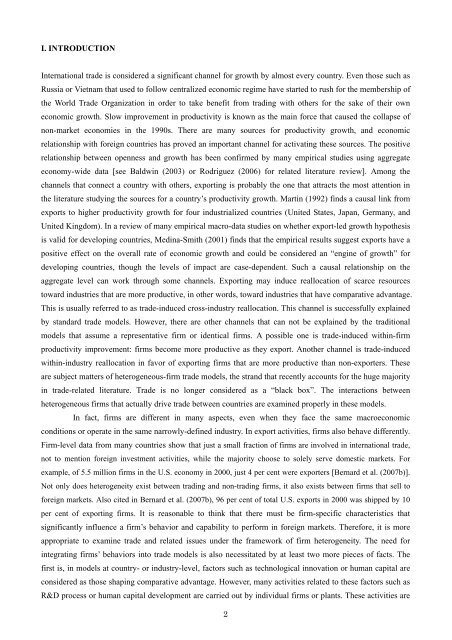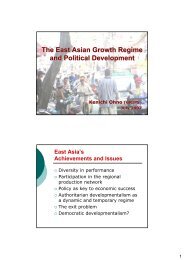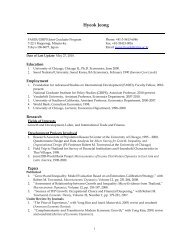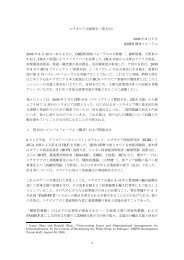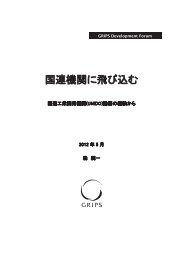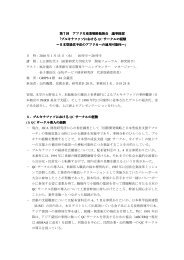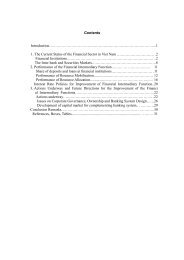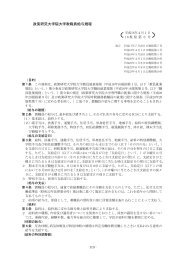Evidence from Firm-level Data in Vietnam
Evidence from Firm-level Data in Vietnam
Evidence from Firm-level Data in Vietnam
You also want an ePaper? Increase the reach of your titles
YUMPU automatically turns print PDFs into web optimized ePapers that Google loves.
I. INTRODUCTIONInternational trade is considered a significant channel for growth by almost every country. Even those such asRussia or <strong>Vietnam</strong> that used to follow centralized economic regime have started to rush for the membership ofthe World Trade Organization <strong>in</strong> order to take benefit <strong>from</strong> trad<strong>in</strong>g with others for the sake of their owneconomic growth. Slow improvement <strong>in</strong> productivity is known as the ma<strong>in</strong> force that caused the collapse ofnon-market economies <strong>in</strong> the 1990s. There are many sources for productivity growth, and economicrelationship with foreign countries has proved an important channel for activat<strong>in</strong>g these sources. The positiverelationship between openness and growth has been confirmed by many empirical studies us<strong>in</strong>g aggregateeconomy-wide data [see Baldw<strong>in</strong> (2003) or Rodriguez (2006) for related literature review]. Among thechannels that connect a country with others, export<strong>in</strong>g is probably the one that attracts the most attention <strong>in</strong>the literature study<strong>in</strong>g the sources for a country’s productivity growth. Mart<strong>in</strong> (1992) f<strong>in</strong>ds a causal l<strong>in</strong>k <strong>from</strong>exports to higher productivity growth for four <strong>in</strong>dustrialized countries (United States, Japan, Germany, andUnited K<strong>in</strong>gdom). In a review of many empirical macro-data studies on whether export-led growth hypothesisis valid for develop<strong>in</strong>g countries, Med<strong>in</strong>a-Smith (2001) f<strong>in</strong>ds that the empirical results suggest exports have apositive effect on the overall rate of economic growth and could be considered an “eng<strong>in</strong>e of growth” fordevelop<strong>in</strong>g countries, though the <strong>level</strong>s of impact are case-dependent. Such a causal relationship on theaggregate <strong>level</strong> can work through some channels. Export<strong>in</strong>g may <strong>in</strong>duce reallocation of scarce resourcestoward <strong>in</strong>dustries that are more productive, <strong>in</strong> other words, toward <strong>in</strong>dustries that have comparative advantage.This is usually referred to as trade-<strong>in</strong>duced cross-<strong>in</strong>dustry reallocation. This channel is successfully expla<strong>in</strong>edby standard trade models. However, there are other channels that can not be expla<strong>in</strong>ed by the traditionalmodels that assume a representative firm or identical firms. A possible one is trade-<strong>in</strong>duced with<strong>in</strong>-firmproductivity improvement: firms become more productive as they export. Another channel is trade-<strong>in</strong>ducedwith<strong>in</strong>-<strong>in</strong>dustry reallocation <strong>in</strong> favor of export<strong>in</strong>g firms that are more productive than non-exporters. Theseare subject matters of heterogeneous-firm trade models, the strand that recently accounts for the huge majority<strong>in</strong> trade-related literature. Trade is no longer considered as a “black box”. The <strong>in</strong>teractions betweenheterogeneous firms that actually drive trade between countries are exam<strong>in</strong>ed properly <strong>in</strong> these models.In fact, firms are different <strong>in</strong> many aspects, even when they face the same macroeconomicconditions or operate <strong>in</strong> the same narrowly-def<strong>in</strong>ed <strong>in</strong>dustry. In export activities, firms also behave differently.<strong>Firm</strong>-<strong>level</strong> data <strong>from</strong> many countries show that just a small fraction of firms are <strong>in</strong>volved <strong>in</strong> <strong>in</strong>ternational trade,not to mention foreign <strong>in</strong>vestment activities, while the majority choose to solely serve domestic markets. Forexample, of 5.5 million firms <strong>in</strong> the U.S. economy <strong>in</strong> 2000, just 4 per cent were exporters [Bernard et al. (2007b)].Not only does heterogeneity exist between trad<strong>in</strong>g and non-trad<strong>in</strong>g firms, it also exists between firms that sell toforeign markets. Also cited <strong>in</strong> Bernard et al. (2007b), 96 per cent of total U.S. exports <strong>in</strong> 2000 was shipped by 10per cent of export<strong>in</strong>g firms. It is reasonable to th<strong>in</strong>k that there must be firm-specific characteristics thatsignificantly <strong>in</strong>fluence a firm’s behavior and capability to perform <strong>in</strong> foreign markets. Therefore, it is moreappropriate to exam<strong>in</strong>e trade and related issues under the framework of firm heterogeneity. The need for<strong>in</strong>tegrat<strong>in</strong>g firms’ behaviors <strong>in</strong>to trade models is also necessitated by at least two more pieces of facts. Thefirst is, <strong>in</strong> models at country- or <strong>in</strong>dustry-<strong>level</strong>, factors such as technological <strong>in</strong>novation or human capital areconsidered as those shap<strong>in</strong>g comparative advantage. However, many activities related to these factors such asR&D process or human capital development are carried out by <strong>in</strong>dividual firms or plants. These activities are2


